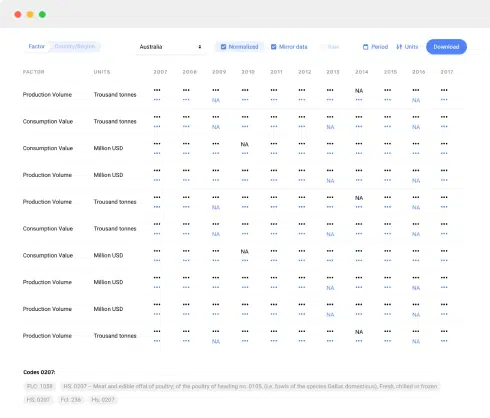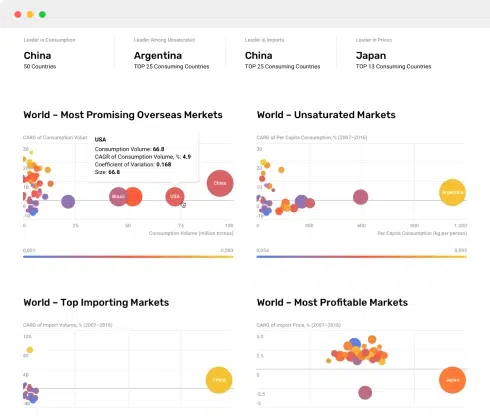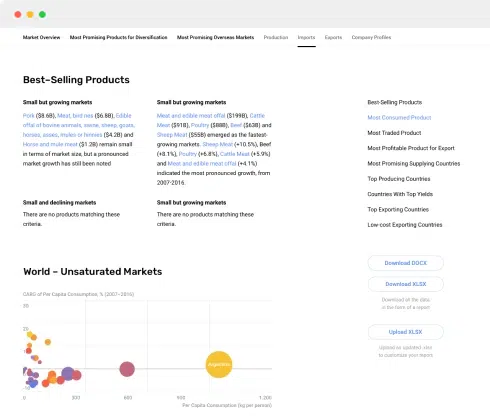
Sony and Beats Dominate Premium Segment with 54% Market Share by Value, Soundcore Leads Volume with 8.2% as Price Wars Intensify Below $75
In the dynamic and highly competitive headphones market, characterized by rapid technological innovation and shifting consumer preferences, a granular understanding of brand positioning is paramount for strategic decision-making. The proliferation of e-commerce, accelerated by macroeconomic factors and changes in consumer behavior, has made marketplaces like Amazon the primary battleground for market share. This analysis leverages real-time data to dissect the competitive landscape, providing actionable insights for marketing, pricing, and portfolio strategy. The geographic focus on delivery to ZIP code 60007 provides a specific lens on logistics, availability, and regional pricing tactics that influence overall market dynamics.
The data underpinning this analysis is sourced from IndexBox's proprietary monitoring tools, which aggregate and process listings from the Amazon marketplace in the United States. The dataset reflects product offerings and consumer engagement metrics for the specified search keyword, with delivery parameters set to ZIP code 60007. This ensures the analysis captures a realistic snapshot of availability and competitive pressure within a specific logistical framework. The full dataset and ongoing monitoring capabilities are accessible via the IndexBox platform at: https://app.indexbox.io/brands/851830/840
Rating vs Reviews: Mapping Brand Perception and Momentum
The scatter plot of Rating versus Reviews segments brands into four distinct quadrants, each requiring a tailored strategic approach. The High Rating / High Reviews quadrant, occupied by Star brands like Sony, Beats, and Audio-Technica, represents established market leaders with strong consumer trust and proven product quality. Their strategy should focus on defending their position through continuous innovation, leveraging their positive reputation for premium product launches and brand extensions. The High Rating / Low Reviews quadrant, featuring Niche players like Linsoul and JBL (in this context), indicates high product satisfaction but limited market reach; these brands must invest in targeted marketing and influencer partnerships to amplify awareness and convert their high quality into sales volume.
Brands in the Low Rating / High Reviews quadrant, such as Sennheiser and JVC, are classified as Rising but carry significant risk; their high review count indicates strong initial sales or marketing pull, but the middling rating suggests quality or expectation mismatches that could hamper long-term growth. A critical initiative for these brands is to implement aggressive post-purchase feedback loops, address quality control issues, and actively manage negative reviews to prevent a slide into the Problematic quadrant. The Low Rating / Low Reviews quadrant, containing Problematic brands like Plantronics, Jabra, and Monster, signals a crisis of relevance or quality; a fundamental product reassessment, potentially coupled with a disruptive repositioning or a strategic pivot towards a new feature set, is urgently required to avoid market exit.
Price vs Sales Volume: Decoding Pricing Strategy Elasticity
The analysis of Average Price against Sales Volume reveals clear strategic archetypes and their associated volume outcomes. The Low Price / High Volume cluster, including volume leaders like Soundcore, JBL, and MUSICOZY, operates on a penetration strategy, competing fiercely in the highly elastic sub-$120 segment; their high number of offers (200-300+) creates significant shelf presence but risks cannibalization, necessitating careful SKU management and feature differentiation. Conversely, the High Price / High Volume quadrant, occupied solely by Sony and Sennheiser, demonstrates the successful execution of a premium-volume strategy, leveraging strong brand equity to command prices above $200 while maintaining robust sales, indicating relatively inelastic demand within their loyal customer base.
The High Price / Low Volume quadrant, featuring Audio-Technica, Jabra, and Plantronics, represents a classic niche premium strategy with high margins but limited total addressable market; these brands should focus on maximizing profitability per SKU rather than pursuing volume, perhaps by bundling accessories or emphasizing exclusive technology. The Low Price / Low Volume position of Linsoul and JVC is the most challenging, suggesting a lack of clear competitive advantage; these brands must either drastically reduce costs to compete on price more effectively or find a definitive feature-based differentiation to justify a price increase and escape this unprofitable quadrant. Calculating approximate elasticity by cluster shows the low-price segment is highly sensitive to changes, while the premium segment exhibits stickiness, allowing for more strategic pricing maneuvers.
Price Distribution: Identifying the Market's Sweet Spots
The price distribution histogram with Kernel Density Estimation (KDE) reveals a highly right-skewed market, with the vast majority of offers concentrated below $150. The primary mass of the market, and thus the core competitive arena, lies between approximately $50 and $120, representing the mainstream consumer's willingness to pay for quality wireless and noise-cancelling features. A significant secondary peak appears in the $200-$300 range, which is the domain of established premium brands like Sony and Sennheiser; this "affordable premium" segment offers high margins with substantial volume potential for brands with the requisite equity.
Notable anomalies in the long tail, with prices extending beyond $500 and even above $2000, indicate the presence of specialized professional audio equipment, limited editions, or potential grey market imports. For assortment segmentation, brands should target specific price tiers: value brands must dominate the $50-$120 range with a focused portfolio, mainstream brands should compete in both the $120-$180 and $200-$300 brackets, and premium brands can explore the $300+ niche with high-specification products. Testing scenarios of a ±10% price change within these bands is crucial to understand elasticity without triggering a price war, while monitoring the ultra-premium segment for counterfeit risks is advised.
Market Share by Volume: Leadership and Portfolio Strategy
The market share distribution by sales volume highlights a fragmented but top-heavy market. Soundcore leads with 8.2% share, followed closely by TOZO (6.7%) and JBL (6.3%), indicating that the volume game is won in the budget-to-mid-range segments. The collective share of the "Others" category, at a substantial 20.2%, is critically important; breaking down this segment would likely reveal emerging brands and white-label manufacturers that are applying constant price pressure on the top 10. For volume leaders like Soundcore and TOZO, the strategy is to defend share through brand building and incremental innovation, moving beyond pure price competition.
For brands in the middle of the pack, such as Skullcandy, Samsung, and JLab, portfolio diversification is key—exploring adjacent categories like gaming headsets or fitness-focused earphones can open new growth vectors without direct confrontation in the saturated music-listening space. The top players must also analyze their share relative to estimated marketing spend; a brand like Beats, with lower volume than Soundcore but immense brand value, likely achieves its position with superior efficiency, a lesson for others investing in brand equity over purely performance marketing.
Price Distribution by Brand: Assortment and Positioning Analysis
The boxplot analysis of price distribution for selected brands reveals starkly different assortment and positioning strategies. MUSICOZY exhibits an extremely tight and low price range ($15-$82), confirming a focused, no-frills budget strategy with minimal variability. In contrast, Linsoul displays an enormous range ($13-$413) with numerous high-end outliers, signaling a broad portfolio aimed at everyone from casual listeners to audiophiles, which risks muddying its brand positioning. JVC and Plantronics show similarly wide interquartile ranges, indicating a attempt to cover multiple segments, but this can lead to internal cannibalization and confused marketing messages.
Audio-Technica maintains a consistently premium positioning, with its entire boxplot sitting above $100 and outliers pushing towards $500, reinforcing its niche expertise. Recommendations for assortment adjustment are clear: brands like Linsoul and Plantronics should rationalize their portfolios, perhaps by culling low-performing SKUs at the extreme ends of their range to focus on a more coherent price band that aligns with their core brand identity. The significant number of high-value outliers for Audio-Technica and Linsoul likely represent specialized professional gear or limited editions, which can be retained for halo effect but should not distract from the core assortment strategy. Avoiding overlapping price ranges with direct competitors requires precise feature differentiation to justify price premiums.
Custom Search Request: On-Demand Competitive Intelligence
The static analysis provided is a snapshot in time; sustained advantage requires continuous monitoring. The IndexBox platform's "Custom Search Request" panel enables this through on-demand parsing. A marketing director can use this function to automate the tracking of specific competitor promotions, alerting the team when a key rival drops prices on benchmark products or launches a new series. This API-driven capability can be integrated directly into Business Intelligence (BI) dashboards, feeding live market data into weekly performance reviews and strategic planning sessions, transforming reactive analysis into proactive strategy.
Conclusion
This analysis underscores a headphones market bifurcated into a high-volume, low-price segment and a high-value, brand-driven premium segment. The key to success lies not in competing everywhere but in choosing a clear strategic quadrant—be it volume leader, premium authority, or value niche—and aligning product development, marketing spend, and assortment strategy accordingly. For investors, the opportunities lie in brands that have demonstrably cracked the code on either operational excellence for the volume game or brand building for the premium game. New entrants face significant barriers to entry in both scale and brand recognition, suggesting a strategy focused on hyper-specific differentiation is more viable than a broad assault. Regular monitoring through IndexBox is not an option but a necessity to navigate this rapidly evolving landscape, track the movement of brands between quadrants, and make data-driven decisions that protect and grow market share.
1. INTRODUCTION
Making Data-Driven Decisions to Grow Your Business
- REPORT DESCRIPTION
- RESEARCH METHODOLOGY AND THE AI PLATFORM
- DATA-DRIVEN DECISIONS FOR YOUR BUSINESS
- GLOSSARY AND SPECIFIC TERMS
2. EXECUTIVE SUMMARY
A Quick Overview of Market Performance
- KEY FINDINGS
- MARKET TRENDSThis Chapter is Available Only for the Professional EditionPRO
3. MARKET OVERVIEW
Understanding the Current State of The Market and its Prospects
- MARKET SIZE: HISTORICAL DATA (2012–2024) AND FORECAST (2025–2035)
- MARKET STRUCTURE: HISTORICAL DATA (2012–2024) AND FORECAST (2025–2035)
- TRADE BALANCE: HISTORICAL DATA (2012–2024) AND FORECAST (2025–2035)
- PER CAPITA CONSUMPTION: HISTORICAL DATA (2012–2024) AND FORECAST (2025–2035)
- MARKET FORECAST TO 2035
4. MOST PROMISING PRODUCTS FOR DIVERSIFICATION
Finding New Products to Diversify Your Business
- TOP PRODUCTS TO DIVERSIFY YOUR BUSINESS
- BEST-SELLING PRODUCTS
- MOST CONSUMED PRODUCTS
- MOST TRADED PRODUCTS
- MOST PROFITABLE PRODUCTS FOR EXPORTS
5. MOST PROMISING SUPPLYING COUNTRIES
Choosing the Best Countries to Establish Your Sustainable Supply Chain
- TOP COUNTRIES TO SOURCE YOUR PRODUCT
- TOP PRODUCING COUNTRIES
- TOP EXPORTING COUNTRIES
- LOW-COST EXPORTING COUNTRIES
6. MOST PROMISING OVERSEAS MARKETS
Choosing the Best Countries to Boost Your Export
- TOP OVERSEAS MARKETS FOR EXPORTING YOUR PRODUCT
- TOP CONSUMING MARKETS
- UNSATURATED MARKETS
- TOP IMPORTING MARKETS
- MOST PROFITABLE MARKETS
7. PRODUCTION
The Latest Trends and Insights into The Industry
- PRODUCTION VOLUME AND VALUE: HISTORICAL DATA (2012–2024) AND FORECAST (2025–2035)
8. IMPORTS
The Largest Import Supplying Countries
- IMPORTS: HISTORICAL DATA (2012–2024) AND FORECAST (2025–2035)
- IMPORTS BY COUNTRY: HISTORICAL DATA (2012–2024)
- IMPORT PRICES BY COUNTRY: HISTORICAL DATA (2012–2024)
9. EXPORTS
The Largest Destinations for Exports
- EXPORTS: HISTORICAL DATA (2012–2024) AND FORECAST (2025–2035)
- EXPORTS BY COUNTRY: HISTORICAL DATA (2012–2024)
- EXPORT PRICES BY COUNTRY: HISTORICAL DATA (2012–2024)
10. PROFILES OF MAJOR PRODUCERS
The Largest Producers on The Market and Their Profiles
LIST OF TABLES
- Key Findings In 2024
- Market Volume, In Physical Terms: Historical Data (2012–2024) and Forecast (2025–2035)
- Market Value: Historical Data (2012–2024) and Forecast (2025–2035)
- Per Capita Consumption: Historical Data (2012–2024) and Forecast (2025–2035)
- Imports, In Physical Terms, By Country, 2012–2024
- Imports, In Value Terms, By Country, 2012–2024
- Import Prices, By Country, 2012–2024
- Exports, In Physical Terms, By Country, 2012–2024
- Exports, In Value Terms, By Country, 2012–2024
- Export Prices, By Country, 2012–2024
LIST OF FIGURES
- Market Volume, In Physical Terms: Historical Data (2012–2024) and Forecast (2025–2035)
- Market Value: Historical Data (2012–2024) and Forecast (2025–2035)
- Market Structure – Domestic Supply vs. Imports, in Physical Terms: Historical Data (2012–2024) and Forecast (2025–2035)
- Market Structure – Domestic Supply vs. Imports, in Value Terms: Historical Data (2012–2024) and Forecast (2025–2035)
- Trade Balance, In Physical Terms: Historical Data (2012–2024) and Forecast (2025–2035)
- Trade Balance, In Value Terms: Historical Data (2012–2024) and Forecast (2025–2035)
- Per Capita Consumption: Historical Data (2012–2024) and Forecast (2025–2035)
- Market Volume Forecast to 2035
- Market Value Forecast to 2035
- Market Size and Growth, By Product
- Average Per Capita Consumption, By Product
- Exports and Growth, By Product
- Export Prices and Growth, By Product
- Production Volume and Growth
- Exports and Growth
- Export Prices and Growth
- Market Size and Growth
- Per Capita Consumption
- Imports and Growth
- Import Prices
- Production, In Physical Terms: Historical Data (2012–2024) and Forecast (2025–2035)
- Production, In Value Terms: Historical Data (2012–2024) and Forecast (2025–2035)
- Imports, In Physical Terms: Historical Data (2012–2024) and Forecast (2025–2035)
- Imports, In Value Terms: Historical Data (2012–2024) and Forecast (2025–2035)
- Imports, In Physical Terms, By Country, 2024
- Imports, In Physical Terms, By Country, 2012–2024
- Imports, In Value Terms, By Country, 2012–2024
- Import Prices, By Country, 2012–2024
- Exports, In Physical Terms: Historical Data (2012–2024) and Forecast (2025–2035)
- Exports, In Value Terms: Historical Data (2012–2024) and Forecast (2025–2035)
- Exports, In Physical Terms, By Country, 2024
- Exports, In Physical Terms, By Country, 2012–2024
- Exports, In Value Terms, By Country, 2012–2024
- Export Prices, By Country, 2012–2024


